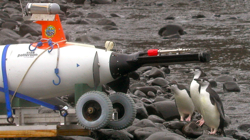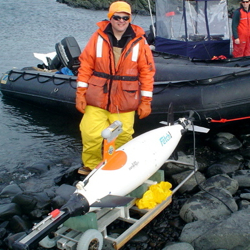Antarctica
In February 2005, Dr. Mark Patterson of the Autonomous Systems Lab at the Virginia Institute of Marine Science partnered with Dr. David Demer of the Southwest Fisheries Science Center to investigate an Antarctic coastal ecosystem using the autonomous underwater vehicle Fetch 1 and other tools.
The expedition, which took place between February 1-9, explored the waters near Cape Shirreff on Livingston Island, South Shetlands.
 The goal of the project was to field test the use of a small
AUV like Fetch 1 in the challenging
waters of the Southern Ocean. Shallow and highly variable bathymetry makes this
area unsuitable for study from large ships, and the frigid and seal-infested
waters make it uncomfortable and dangerous for SCUBA divers. A specific objective
was to determine if Fetch 1 and its
side-scan sonar unit could be used to image and identify krill swarms.
The goal of the project was to field test the use of a small
AUV like Fetch 1 in the challenging
waters of the Southern Ocean. Shallow and highly variable bathymetry makes this
area unsuitable for study from large ships, and the frigid and seal-infested
waters make it uncomfortable and dangerous for SCUBA divers. A specific objective
was to determine if Fetch 1 and its
side-scan sonar unit could be used to image and identify krill swarms.
Antarctic krill, which aggregate in large swarms and layers in the waters just offshore of the island, provide the main food source for Cape Shirreff’s seasonally resident fur seal and penguin populations.
Fetch I was deployed from a Zodiac several times as a field test for more extensive deployments in future field seasons. Collected data sets were analyzed to study the relationships between the oceanography and biology of the near-shore area.
Overall, Fetch 1 dove 55 times to depths as great as 70 m, and traveled an estimated 12.1 nautical miles. During these dives, Fetch 1 collected 260 Mb of 600 kHz side scan sonar data, 4 hours of underwater video, and simultaneously logged conductivity, temperature, depth, bathymetry, and dissolved-oxygen data at 2 Hz. AUV operations were conducted from the Zodiac under varying conditions of rain, fog, high winds, and high waves.
Lessons learned for future deployments
 Fetch 1 carried
tags transmitting on 38 and 50 kHz, and locating the vehicle using the pinger
locator proved essential on several occasions when visibility was reduced by
fog and whitecaps. It was also necessary to determine when the vehicle fins
were knocked around during deployments, when the vehicle inadvertently hit the
bottom in uncharted areas (the altimeter onboard cannot avoid collisions with
vertical cliffs), and when marine algae had fouled the AUV's propeller. It was
also necessary to stay vigilant of leopard seals becoming overly interested in
AUV operations and operators.
Fetch 1 carried
tags transmitting on 38 and 50 kHz, and locating the vehicle using the pinger
locator proved essential on several occasions when visibility was reduced by
fog and whitecaps. It was also necessary to determine when the vehicle fins
were knocked around during deployments, when the vehicle inadvertently hit the
bottom in uncharted areas (the altimeter onboard cannot avoid collisions with
vertical cliffs), and when marine algae had fouled the AUV's propeller. It was
also necessary to stay vigilant of leopard seals becoming overly interested in
AUV operations and operators.

